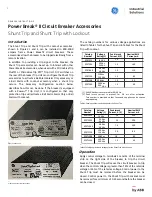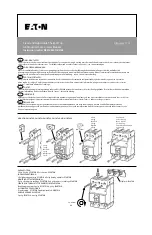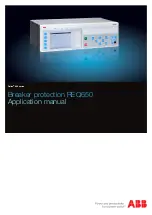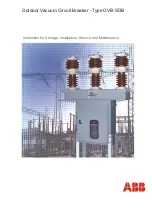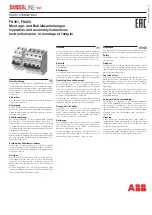
IB-5909
The tape with sealer is used almost exclusively
on short runs, close consecutive bends, and where
the bus work runs into apparatus mounted on the
switchboard (potheads, current transformers, etc.) .
Tape and sealer are provided for covering main
connections, bends made in the field, and flexible
connectors. When such a connection is to be made
in the field, the wrapping should be as follows:
Use the sealer to fill all voids and to cover
hardware and all irregular surfaces by 1/8".
Wrap five
(5)
windings of tape with one half
of each winding lapped-over to form ten (10)
layers. The overlaps should be staggered.
Do not leave any voids or air spaces in the
sealer or between the layers of tape. The tape
should extend 1-1 /2" over the bus insulation
tubing where possible.
CONNECTION OF PRIMARY CABLES
In general, there are three common methods of
making primary cable entrance connections.
Synthetic Covered Cable with Clamps
For this type cable, prepare for entrance to con
nection lugs, and securely tighten lug clamps. The
cable should be prepared as specified by the cable
manufacturer. Use sealer and tape as described
in previous section. Mount cable through insulat
ing support and clamp securely.
Lead Covered Cable with Wiping
Sleeve
When cable diameters are specified on order,
the wiping sleeves are furnished cut off to fit the
cables. Uncut wiping sleeves are fitted to the
cables as follows:
Wrap a cord (or tape) around the cable to obtain
the circumference. Then wrap the cord around the
wiping sleeve cone and mark the cone slightly
above the cord. Saw off cone. Ream sharp edges
of cone with round file.
Wiping sleeves are furnished untinned unless
tinning is specified. Sleeves should be freshly
tinned by applying flux and dipping in hot solder.
When installing the wiping sleeve, the lead
sheath should extend into the sleeve fitting for
one inch minimum. The end of the sheath should
be belled over and if required by the operating
voltage, a stress relief cone applied.
To wipe the joint, scrape the lead sheath clean
approximately three inches beyond the end of the
cone. Apply stearine flux to the cleaned sheath
and to the cone. Then make the wiped joint in the
usual manner. Fill wiping sleeve with the com
pound supplied.
Lead Covered Cable with Pothead
The same method of fitting as for wiping sleeves
can be used to fit the pothead wiping sleeve to the
cables. In the case of the pothead with wiping
sleeve, the lead sheath should extend into the pot
head for one inch minimum, bell over the end of
6
the sheath, and add a stress relief cone if required·
Clean the sheath about three inches beyond the
end of the cone and apply stearine flux to end of
the cone and the sheatlt. Wipe the joint in the
usual manner.
On inverted potheads, the lead sheath should
be extended down into the pothead body beyond
the wiping sleeve flange joint so that the sheath
will terminate below the level of the compound.
To vent the top end of the inverted pothead sleeve
while compounding, wipe the joint with a greased
wire inserted between the sleeve and the sheath.
Pull out the wire to provide a small hole to vent
the air. After the pothead has been filled with
compound, seal the hole with solder.
Shielded Cable
When shielded cable is connected to any ter
minator, proper stress relief cones must be applied.
Roof Bushings
Roof bushings, for cable entrance, are shipped
detached from the housing, and must be mounted
in place when the switchgear is installed. Each
bushing is furnished with a gasket that must be
properly inserted between the roof and the bush
ing flange, using the adhesive and grease fur
nished for the purpose, to provide a weathertight
seal. Cement the gasket to the roof using a layer
of the adhesive. Then lubricate the remaining flat
surface of the gasket with a thin coat of the grease.
Now put the bushing in place and bolt to the
structure.
CONNECTION TO GROUND BUS
Ground bus bars are bolted to the frames of the
housings at the factory before shipment. \\1hen
housings are shipped separately, it is necessary
to bolt the ground bus to the framing. Ground bus
bars should be solidly and permanently con
nected to the station ground by means of a
c.'
ble
or bus of cross section not less than that of the
housing ground bus.
Cable or bus should not be in conduit, and
should take the most direct path.
CONNECTION TO CONTROL SOURCE
The control source wiring to the switchgear
should be of larger cross section than the balance
of the control wiring in order to reduce the voltage
drop, particularly when this source is some distance
from the switchgear. Provision is made in the
switchgear, in the form of heavy duty terminal
blocks, for the connection of these control source
leads. The leads should first be checked for proper
electrical sequence before the connection is made.
Secondary and Control Connections
All
secondary and control connections on metal
clad switchgear are factory wired in accordance
• ,
f
'
www
. ElectricalPartManuals
. com
Содержание 5HV-150
Страница 10: ...I w w w E l e c t r i c a l P a r t M a n u a l s c o m ...
Страница 12: ...w w w E l e c t r i c a l P a r t M a n u a l s c o m ...
Страница 14: ...w w w E l e c t r i c a l P a r t M a n u a l s c o m ...
Страница 15: ...w w w E l e c t r i c a l P a r t M a n u a l s c o m ...
Страница 18: ... J w w w E l e c t r i c a l P a r t M a n u a l s c o m ...
Страница 20: ...w w w E l e c t r i c a l P a r t M a n u a l s c o m ...





















